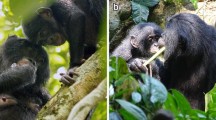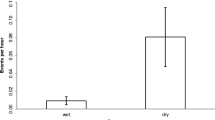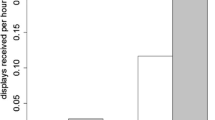Abstract
Tolerated transfer of food among adults is rare among primates, except in humans. Here, we present data on a consistent pattern of tolerated intersexual transfer of food (held in hand, foot, or mouth by the owner) among adult orangutans, in two different natural populations (Pongo abelii and Pongo pygmaeus wurmbii), based on ca. 9,000 h of focal observation per site. Although rare, intersexual food transfers were disproportionately from males to sexually active females and involved food that was equally available to both sexes. There was no evidence for direct trading of food for social favors (mating, grooming, or agonistic support) or for sharing under pressure of harassment. However, females frequently protested with loud screams when males, especially unflanged ones, attempted to take food they possessed, and also when males responded aggressively to their taking attempt. Since associations ended sooner when the female emitted noisy calls, a male who did not allow a female to take food from him risked losing the association. These findings support the hypothesis that by taking food, a sexually active female may test the male's tendency toward violence. Thus, intersexual food taking in orangutans is based on female leverage, resulting in a species-wide female entitlement to male “generosity”. The inhibition of food defense required for this kind of transaction may also form the basis for sharing patterns among species in which nutritional benefits have become important, such as chimpanzees and perhaps human foragers.


Similar content being viewed by others
References
Bliege Bird R, Smith EA, Bird DW (2001) The hunting handicap: costly signaling in human foraging strategies. Behav Ecol Sociobiol 50:9–19
Blurton Jones NG (1984) A selfish origin for human food sharing: tolerated theft. Ethol Sociobiol 5:1–3
Blurton Jones NG (1987) Tolerated theft, suggestions about the ecology and evolution of sharing, hoarding and scrounging. Soc Sci Info 26:31–54
Boesch C, Boesch-Achermann H (2000) The chimpanzees of the Taï forest: behavioural ecology and evolution. Oxford University Press, Oxford
Brown GR, Almond REA, van Bergen Y (2004) Begging, stealing, and offering: food transfer in nonhuman primates. Adv Stud Behav 34:265–295
Clutton-Brock TH (1991) The evolution of parental care. Princeton University Press, Princeton NJ
de Kort SR, Emery NJ, Clayton NS (2006) Food sharing in jackdaws, Corvus monedula: what, why and with whom? Anim Behav 62:297–304
de Waal FBM (1989) Food sharing and reciprocal obligations among chimpanzees. J Hum Evol 18:433–459
de Waal FBM (1997) The chimpanzee's service economy: food for grooming. Evol Hum Behav 18:375–386
Delgado RA (2003) The function of adult male long calls in wild orangutans (Pongo pygmaeus). Ph.D. dissertation, Duke University, Durham NC
Feistner ATC, McGrew WC (1989) Food-sharing in primates: a critical review. In: Seth PK, Seth S (eds) Perspectives in primate biology, vol 3. Today and Tomorrow's Printers and Publishers, New Delhi, pp 21–36
Fox AE (2002) Female tactics to reduce sexual harassment in the Sumatran orangutan (Pongo pygmaeus abelli). Behav Ecol Sociobiol 52:93–101
Fruth B, Hohmann G (2002) How bonobos handle hunts and harvests: why share food? In: Boesch C, Hohmann G, Marchant LF (eds) Behavioural diversity in chimpanzees and bonobos. Cambridge University Press, Cambridge, pp 231–243
Galdikas BMF (1981) Orangutan reproduction in the wild. In: Graham CE (ed) Reproductive biology of the great apes: comparative and biomedical perspectives. Academic, New York, pp 281–300
Gilby IC (2006) Meat sharing among Gombe chimpanzees: harassment and reciprocal exchange. Anim Behav 71:953–963
Gilby IC, Eberly LE, Pintea L, Pusey AE (2006) Ecological and social influences on the hunting behaviour of wild chimpanzees, Pan troglodytes schweinfurthii. Anim Behav 72:169–180
Gintis H, Smith EA, Bowles S (2001) Costly signaling and cooperation. J Theor Biol 213:103–119
Goodall J (1986) The chimpanzees of Gombe. Harvard University Press, Cambridge
Goossens B, Setchell JM, James SS, Funk SM, Chikhi L, Abulani A, Ancrenaz M, Lackman-Ancrenaz I, Bruford MW (2006) Philopatry and reproductive success in Bornean orang-utans (Pongo pygmaeus). Mol Ecol 15:2577–2588
Grafen A (1990) Biological signals as handicaps. J Theor Biol 144:517–546
Gurven M (2004) To give and to give not: the behavioral ecology of human food transfers. Behav Brain Sci 27:543–583
Hamilton WD (1964) The genetical evolution of social behaviour. J Theor Biol 7:1–52
Hasegawa T, Hiraiwa-Hasegawa M (1990) Sperm competition and mating behavior. In: Nishida T (ed) The chimpanzees of the Mahale mountains: sexual and life history strategies. University of Tokyo Press, Tokyo, pp 115–132
Hawkes K (1991) Showing off: tests of an hypothesis about men's foraging goals. Ethol Sociobiol 12:29–54
Hawkes K (1993) Why hunter–gatherers work. An ancient version of the problem of public goods. Curr Anthropol 34:341–361
Hockings KJ, Humle T, Anderson JR, Biro D, Sousa C, Ohashi G, Matsuzawa T (2007) Chimpanzees share forbidden fruit. PloS ONE 2(9):e886. doi:10.1371/journal.pone.0000886
Jaeggi AV, van Noordwijk MA, van Schaik CP (2008) Begging for information: mother–offspring food sharing among wild Bornean orangutans. Am J Primatol 70:533–541
Jensen K, Call J, Tomasello M (2007) Chimpanzees are vengeful but not spiteful. Proc Natl Acad Sci U S A 104:13046–13050
Kalishov A, Zahavi A, Zahavi A (2005) Allofeeding in Arabian babblers (Turdoides squamiceps). J Ornithol 146:141–150
Kano T (1980) Social behavior of wild pygmy chimpanzees (Pan paniscus) of Wamba: a preliminary report. J Hum Evol 9:243–260
Knott CD, Kahlenberg SM (2007) Orangutans in perspective. Forced copulations and female mating resistance. In: Campbell CJ, Fuentes A, MacKinnon KC, Panger M, Bearder SK (eds) Primates in perspective. Oxford University Press, Oxford, pp 290–305
Kummer H, Cords M (1991) Cues of ownership in Macaca fascicularis. Anim Behav 42:529–549
Kuroda S (1984) Interaction over food among pygmy chimpanzees. In: Susman RL (ed) The pygmy chimpanzee. Plenum, New York, pp 301–324
Lewis RJ (2002) Beyond dominance: the importance of leverage. Q Rev Biol 77:149–164
Matsumoto-Oda A (1999) Female choice in the opportunistic mating of wild chimpanzees (Pan troglodytes schweinfurthii) at Mahale. Behav Ecol Sociobiol 46:258–266
Matsumoto-Oda A (2002) Social relationships between cycling females and adult males in Mahale chimpanzees. In: Boesch C, Hohmann G, Marchant LF (eds) Behavioural diversity in chimpanzees and bonobos. Cambridge University Press, Cambridge, pp 168–180
Mitani JC, Watts DP (2001) Why do chimpanzees hunt and share meat? Anim Behav 61:915–924
Mitra Setia T, van Schaik CP (2006) The response of adult orang-utans to flanged male long calls: inferences about their function. Folia Primatol 78:215–226
Muller MN, Kahlenberg SM, Emery Thompson M, Wrangham RW (2007) Male coercion and the costs of promiscuous mating for female chimpanzees. Proc R Soc Lond B 274:1009–1014
Ohashi G (2007) Papaya fruit sharing in wild chimpanzees at Bossou, Guinea. Pan Africa News 14:14–16
Perry S, Rose L (1994) Begging and transfer of coati meat by white-faced capuchin monkeys, Cebus capucinus. Primates 35:409–415
Scheid C, Schmidt J, Noe R (2008) Distinct patterns of food offering and co-feeding in rooks. Anim Behav 76(5):1701–1707. doi:10.1016/j.anbehav.2008.07.023
Schürmann C (1982) Courtship and mating behavior of wild orangutans. In: de Boer LEM (ed) The orangutan: its biology and conservation. Dr W Junk, The Hague, pp 269–284
Singleton I, van Schaik CP (2002) The social organization of Sumatran orang-utans. Folia Primatol 73:1–20
Slocombe KE, Newton-Fisher NE (2005) Fruit sharing between wild adult chimpanzees (Pan troglodytes schweinfurthii): a social significant event? Am J Primatol 65:385–391
Smith EA, Bliege Bird RL (2000) Turtle hunting and tombstone opening: public generosity as costly signaling. Evol Hum Behav 21:245–261
Smith EA, Bliege Bird RL, Bird DW (2003) The benefits of costly signaling: Meriam turtle hunters. Behav Ecol 14:116–126
Stanford CB, Wallis J, Mpongo E, Goodall J (1994) Hunting decisions in wild chimpanzees. Behaviour 131:1–18
Stevens JR, Gilby IC (2004) A conceptual framework for nonkin food sharing: timing and currency of benefits. Anim Behav 67:603–614
Stumpf RM, Boesch C (2005) Does promiscuous mating preclude female choice? Female sexual strategies in chimpanzees (Pan troglodytes verus) of the Tai National Park, Cote d'Ivoire. Behav Ecol Sociobiol 57:511–524
Teleki G (1973) The predatory behaviour of wild chimpanzees. Bucknell University Press, Lewisburg PA
Tutin CEG (1979) Mating patterns and reproductive strategies in a community of wild chimpanzees (Pan troglodytes schweinfurthii). Behav Ecol Sociobiol 6:29–38
van Noordwijk MA, Sauren SEB, Nuzuar Abulani A, Morrogh-Bernard HC, Utami Atmoko SS, van Schaik CP (2009) Development of independence: Sumatran and Bornean orangutans compared. In: Wich SA, Utami Atmoko SS, Mitra Setia T, van Schaik CP (eds) Orangutans: geographic variation in behavioral ecology and conservation. Oxford University Press, Oxford, pp 189–203
van Schaik CP (1999) The socioecology of fission–fusion sociality in orangutans. Primates 40:73–90
van Schaik CP (2004) Among orangutans: red apes and the rise of human culture. Belknap, Cambridge
van Schaik CP, van Hooff JARAM (1996) Towards an understanding of the orangutan's social system. In: McGrew WC, Marchant LF, Nishida T (eds) Great Ape Societies. Cambridge University Press, Cambridge, pp 3–15
van Schaik CP, Wich SA, Utami SS, Odom K (2005) A simple alternative to line transects of nests for estimating orangutan densities. Primates 46:249–254
van Schaik CP, van Noordwijk MA, Vogel ER (2009) Ecological sex differences in wild orangutans. In: Wich SA, Utami Atmoko SS, Mitra Setia T, van Schaik CP (eds) Orangutans: geographic variation in behavioral ecology and conservation. Oxford University Press, Oxford, pp 255–268
von Bayern AMP, de Kort SR, Clayton NS, Emery NJ (2007) The role of food- and object-sharing in the development of social bonds in juvenile jackdaws (Corvus monedula). Behaviour 144:711–733
Watts DP, Mitani JC (2002) Hunting and meat sharing by chimpanzees at Ngogo, Kibale National Park, Uganda. In: Boesch C, Hohmann G, Marchant LF (eds) Behavioural diversity in chimpanzees and bonobos. Cambridge University Press, Cambridge, pp 244–255
West SA, Griffin AS, Gardner A (2006) Social semantics: altruism, cooperation, mutualism, strong reciprocity and group selection. J Evol Biol 20:415–432. doi:10.1111/j.1420-9101.2006.01258.x
White FJ (1994) Food sharing in wild pygmy chimpanzees, Pan paniscus. In: Roeder JJ, Thierry B, Anderson JR, Herrenschmidt N (eds) Current primatology, vol II. Social development, learning and behaviour. Université Louis Pasteur, Strasbourg
Wilson EO (1975) Sociobiology. Belknap, Cambridge
Wrangham RW (1975). The behavioral ecology of chimpanzees in Gombe National Park, Tanzania. Ph.D. thesis, Cambridge University
Wrangham RW, Peterson D (1996) Demonic males: apes and the origins of human violence. Houghton Mifflin, Boston
Acknowledgments
We especially thank Sri Suci Utami Atmoko for information on food transfer in orangutans in Ketambe. We are grateful to the Indonesian government, LIPI (Indonesian Institute of Science), and PHKA (Indonesian Department of Forestry and Nature Conservation) for the permission for long-term research projects in Indonesia. We appreciate the sponsorship and support from and long-term collaboration with Universitas Nasional, Universitas Indonesia, Universitas Syah Kuala, Leuser Management Unit, BOS Jakarta, and BOS-MAWAS Palangkaraya. We also gratefully acknowledge the financial support for field work and data analysis from the L.S.B. Leakey Foundation, Wildlife Conservation Society of New York, Duke University, A.H. Schultz Stiftung, and Universität Zürich. We thank all participants in data collection in both sites, in particular Beth Fox, Ibrahim, Idrusman, Ian Singleton, Bahlias, Samsuar, Abdussammad, Arnold Sitompul, Serge Wich, Ganda, Nadi, Linandi, Rahmatd, Yandi, and all students who worked at Tuanan. We thank Adrian Jaeggi, Katharin Pieta, Karin Isler, David Watts, and anonymous reviewers for discussion and comments. Research was conducted within the framework of a Memorandum of Understanding between UNAS and Duke University and later between UNAS and the University of Zurich. Observation protocols were in compliance with Indonesian laws.
Author information
Authors and Affiliations
Corresponding author
Additional information
Communicated by D. Watts
Rights and permissions
About this article
Cite this article
van Noordwijk, M.A., van Schaik, C.P. Intersexual food transfer among orangutans: do females test males for coercive tendency?. Behav Ecol Sociobiol 63, 883–890 (2009). https://doi.org/10.1007/s00265-009-0728-3
Received:
Revised:
Accepted:
Published:
Issue Date:
DOI: https://doi.org/10.1007/s00265-009-0728-3




